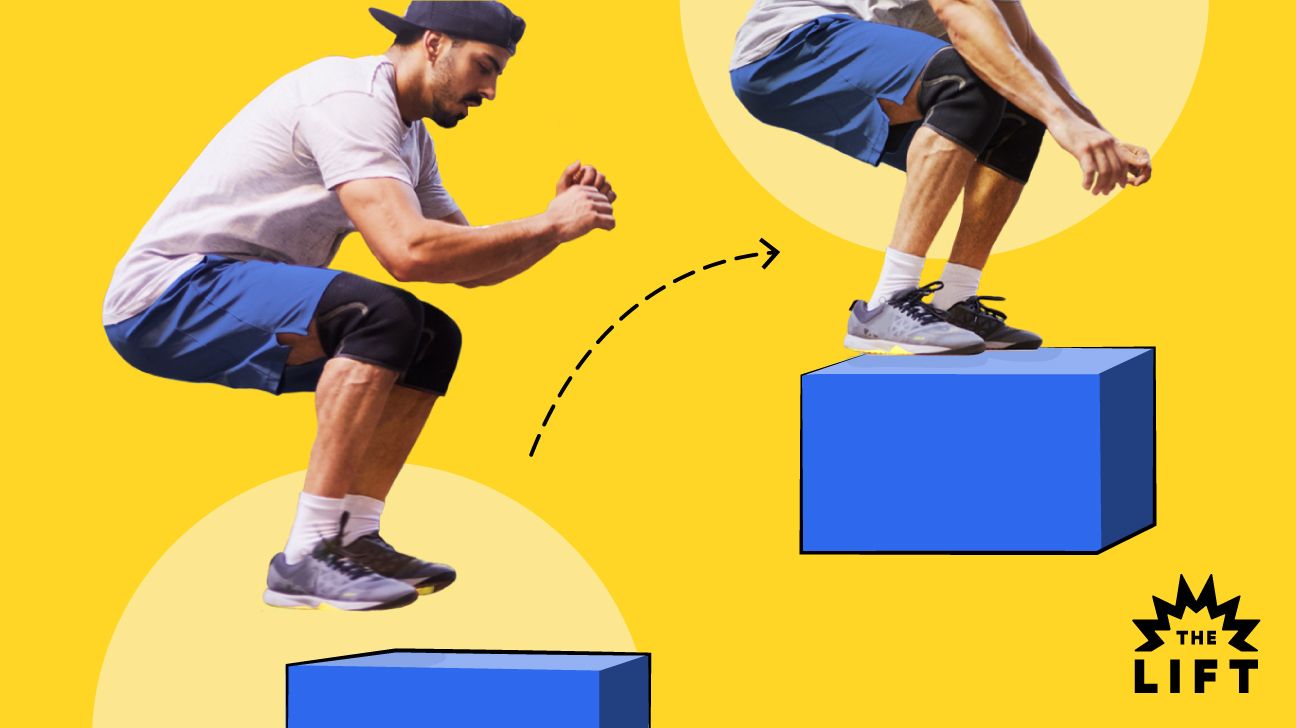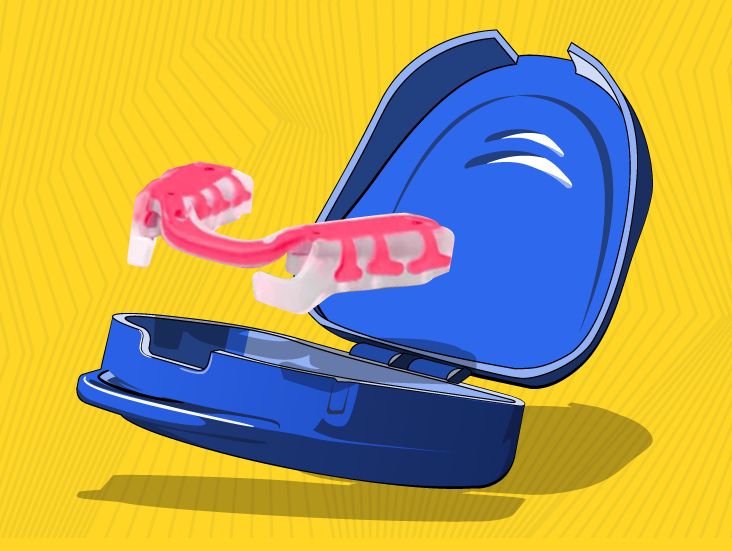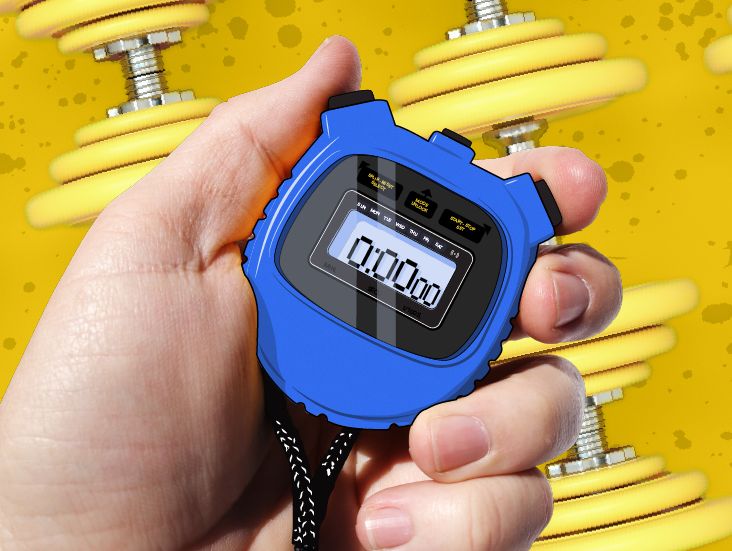
Yeah, yeah — “box jumps” could be the name of a pogo stick emblazoned with poons or a fancy-shmancy board trick. But today, we’re diving deep on box jumps the exercise.
Box jumps are as straightforward as they sound. Your workout includes jumping onto a box. But proper form is essential for maximizing benefit and minimizing risk.
How to do a proper box jump
- Stand with your feet parallel, hip- to shoulder-width apart, and toes 12(ish) inches away from the edge of the box.
- Brace your core, bend knees, and press hips back into a partial squat to initiate movement.
- Bring arms behind your body and sink your weight onto the middle of your feet before springing yourself upward. Swing arms forward for momentum while launching your bod into the air.
- Land evenly on the box with your feet hip-width apart, in a quarter squat.
- Actively press knees out to keep them from collapsing in. Then, extend your hips and squeeze your glutes at the top.
- Keep core braced while stepping down from the box, one foot at a time.
- Repeat, this time stepping down with the opposite foot first.
It might seem easier to just hop back down to the floor after your box jump, but that could lead to physical catastrophe.
“I cannot emphasize enough how dangerous it is to jump back down,” says Pete McCall, a personal trainer, fitness educator, and host of the podcast “All About Fitness.”
Jumping down from the box (also known as “rebounding”) can put significant stress on your Achilles tendon. It also puts unnecessary stress on the connective tissues in your knees.
And if you try to jump backward off the box, you significantly increase your risk of falling, according to McCall. “If you fall, the two things that hit the ground are going to be your bum or the back of your head,” he says.
Cracked coccyx or concussion? No! Thank you!
Now, if you’re a CrossFitter or a speed demon, you might be wondering, “But aren’t rebounding jumps wayyyy faster?”
The answer: They’re a little faster… but negligibly so.
The OG plyometric exercise, box jumps are an explosive movement that can be used to improve your cardiovascular capacity, explosiveness, strength, and/or power — depending on how you program them.
Lower box + higher reps = cardio strength
Higher box + lower reps = explosiveness, power, and strength
To understand how box jumps improve explosiveness and why it matters, you have to understand how muscles are built.
McCall explains: Muscles are made up of two types of muscle fibers: type I and type II. Type I muscle fibers, also known as slow-twitch muscle fibers, are what your body uses for endurance activities.
Type II muscle fibers, also known as fast-twitch muscle fibers, activate more quickly than slow-twitch muscle fibers and are what your body calls on for explosive movements.
“Training your type II muscle fibers through explosive exercises like box jumps will prepare you for when you need to use those muscle fibers in life,” says McCall. “When your type II muscle fibers are de-conditioned, your risk of injury during day-to-day life increases.”
Legs on legs on legs.
More specifically, box jumps work out your:
- quads
- hamstrings
- glutes
- calves
“Box jumps also work your core and arms as well. Though, to be honest, the arm part is negligible,” says New York-based certified strength and conditioning specialist Kristian Flores.
Start with a box height that you know you can jump onto fairly easily. This will obviously build confidence in your ability to complete the exercise.
Once you’re pretty dang comfy with the starting height, moving up should depend on your goal.
According to Flores, jumping onto a lower box (think: 12 to 24 inches) with many repetitions is the best way to train for endurance and improve your cardiovascular output.
“Jumping onto a higher box for fewer repetitions helps us train for power — the ability to generate maximum force in the shortest time possible,” he says.
High AF box jumps may make great social media content, but experts say they’re pretty silly.
When folks post videos of themselves doing box jumps of 50 or 60 inches into the air, what they’re actually doing is launching their torsos a few feet into the air and then quickly pulling their feet up to clear the distance.
“What really high box jumps actually measure is your hip flexibility and how high your hips allow you to bring your feet — not how explosive your lower half is,” says McCall.
In other words, a high box jump is not as beneficial as it is Instagrammable.
Got a bit of box jump phobia? No problem. Scale the movement down to step-ups.
“Step-ups help you build up some of the prerequisite knee and core strength you need to do box jumps in good form,” says McCall. “Simply stepping on the box one foot at a time works most of the same muscles while allowing you to get acquainted with the box in a lower-risk manner.”
Because step-ups are a unilateral exercise that forces you to work one side at a time, they’re actually better at building balance between the two sides than box jumps.
“With box jumps it is still possible to have a side that pushes off the ground or absorbs the landing more than the other,” Flores notes.
Where step-ups fall short, however, is in the explosiveness area. “Typical step-ups just don’t work those type II muscle fibers because they’re not generally very explosive,” says McCall.
If you’re dead set on *not* doing box jumps but still want to build explosiveness, Flores says you can increase the explosiveness of step-ups.
“Rather than simply stepping on the box, plant one foot on the box before explosively driving the opposite knee upward and landing in a quarter squat on top,” he says.
To get even more advanced and fancy, you can attempt a step-up into a jump and land on the same leg.
“This is an advanced move that requires a lot of hip stability, so it’s not for beginners,” Flores warns.
Whether you go hard with a bunch of box jump reps or less intense with a step-up, be sure you have a good gauge for your sense of balance.
Gabrielle Kassel (she/her) is a queer sex educator and wellness journalist who is committed to helping people feel the best they can in their bodies. In addition to Healthline, her work has appeared in publications such as Shape, Cosmopolitan, Well+Good, Health, Self, Women’s Health, Greatist, and more! In her free time, Gabrielle can be found coaching CrossFit, reviewing pleasure products, hiking with her border collie, or recording episodes of the podcast she co-hosts called Bad In Bed. Follow her on Instagram @Gabriellekassel.





